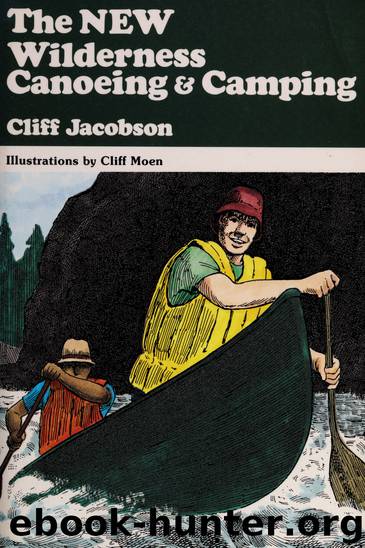The new wilderness canoeing & camping by Jacobson Cliff

Author:Jacobson, Cliff
Language: eng
Format: epub
Tags: Canoes and canoeing, Camping, Wilderness areas -- United States, Wilderness areas -- Canada, Camping, Canoes and canoeing, Wilderness areas, Kanuwandern, Canada, United States
ISBN: 9780934802291
Publisher: Merrillville, Ind. : ICS Books ; Harrisburg, PA : Distributed by Stackpole Books
Published: 1986-02-19T16:00:00+00:00
11 .
1^1^ It All Ti^ether
Every canoeist should have a fundamental knowledge of knot- tying and rope-handling techniques. You will use ropes for lining and tracking your canoe through rapids, erecting a rain tarp, making a clothesline, lifting a bucket of cold water from the depths of a lake, securing your canoe to a car-top carrier, salvage and rescue
operations, and many other purposes.
Many outdoors handbooks define a dozen or more knots. In reality, unless you are a mountain climber or intend to chop down the forest to build rope-lashed furniture (which isn’t even remotely humorous in this age of environmental awareness), you can get along very nicely with just two hitches and two knots. These are the double half-hitch (two half-hitches), sheet bend, bowline, and power-cinch. Those familiar with rope-handling techniques will note the conspicuous absence of the square knot and the tautline hitch. Except for limited first-aid applications the square knot is generally useless, and the much touted tautline hitch has gone the way of the passenger pigeon. The tautline was useful in the days of cotton tents and manila rope; it has been replaced with the much
handier, more versatile, power-cinch.
179
Admittedly, I find that most canoeists can usually get by with just one knot and one hitch - the power-cinch and the sheet bend. These are a must, however, and they should be mastered before you undertake a voyage of significance.
THE DOUBLE HALF-HITCH {two half-hitches)
The double half-hitch is useful for tying a rope to a tree or to the towing link of a canoe. The knot is very secure and tends to tighten itself when a load is applied to the rope.
Figure 11-1 Double Half-Hitch:
THE SHEET BEND
Use the sheet bend for tying two ropes together. The knot works well even if the rope sizes differ greatly. The sheet bend is about the only knot that can be effectively used to join the ends of slippery polypropylene rope.
A friend of mine won five dollars when he fixed a broken waterskiing tow-rope with this knot. When the tow-line snapped, the owner of the ski boat bet my friend that he couldn’t tie the two
Download
This site does not store any files on its server. We only index and link to content provided by other sites. Please contact the content providers to delete copyright contents if any and email us, we'll remove relevant links or contents immediately.
Breath by James Nestor;(2162)
The River by Peter Heller(2152)
Deep by James Nestor(2086)
Fatal Storm by Rob Mundle(2083)
Sea Survival Handbook by Keith Colwell(2044)
Lonely Planet Australia by Lonely Planet(1974)
Iced In by Chris Turney(1853)
Discover Australia by Lonely Planet(1845)
Lonely Planet Maldives (Travel Guide) by Planet Lonely & Masters Tom(1736)
One Girl One Dream by Dekker Laura(1581)
Looking for a Ship by John McPhee(1576)
Ten Degrees of Reckoning: The True Story of a Family's Love and the Will to Survive by Hester Rumberg(1553)
Chicken Soup for the Ocean Lover's Soul by Jack Canfield(1552)
Lonely Planet Australia (Travel Guide) by Lonely Planet & Lonely Planet(1512)
South with the Sun by Lynne Cox(1463)
The Wave In Pursuit of the Rogues, Freaks and Giants of the Ocean(1431)
Diver Down by Michael Ange(1422)
Marlinspike Sailor's Arts and Crafts by Barbara Merry(1412)
The Golden Rules: 10 Steps to World-Class Excellence in Your Life and Work by Bob Bowman & Charles Butler(1385)
